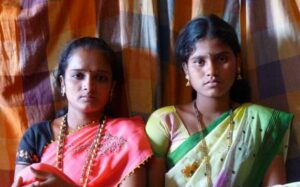By Kate Taylor

In India, the devadasi (day-vah-dah-see) system, a Hindu practice of temple prostitution, has existed more than 5,000 years, says David Dass, executive director of the India Gospel League. In the state of Karnataka where he and his wife live, starving families dedicate hundreds of girls each year to the goddess Yellamma. The children are forced to begin a life of prostitution at age 11 or 12.
“From the very beginning, they’re being exploited as babies,” says Annette Romick, a humanitarian aid worker in India. “Then, when they hit maturity, their bodies are exploited by men. Even when their bodies are no longer desirable to men, they are still exploited and abused because that stigma is on them. They can never escape from it. It’s a trap that they’re stuck in; it’s a living hell that they’re experiencing.”
The word devadasi literally translates to “god’s female servant.” Parents usually choose to dedicate their daughters as infants to the goddess Yellamma in hopes of gaining the goddess’ favor or easing a financial burden.
Once dedicated, a girl is considered to be married to the goddess and is never allowed to marry a man. When the girl reaches physical maturity, she is forced to begin her life as a prostitute.
“Since 1982, the devadasi system has been banned by the government of India and Karnataka,” says Joseph Paul, a Christian pastor ministering among devadasis. “But there are underground practices — nobody knows how they practice and how they dedicate.”
Because the devadasis practice has gone underground, the women work mostly from their homes, only visiting the temple to beg money from worshippers. Many of the prostitutes are trafficked to the red light districts of Mumbai, Pune, Bangalore and other large cities.
“Our parents gave us birth and threw us on the street. Men come and use us, finish their job and go,” says Sugandha, a former devadasis receiving assistance from a non-governmental organization.
In the Hindu religion, devadasis hope for a better life only through the cycle of rebirth. Few devadasis have ever heard the name of Jesus Christ who offers hope for this life and for eternity.
“Their lives have been ruined and they feel like trash that’s just been used over and over again and just discarded,” Romick says. “They need to know the love of Christ, and the only way that they’re going to have that is if we go and tell them.”
Devadasis come mainly from impoverished families of the untouchables class, the lowest rung of Hindu society. Sometimes they receive compensation for their services, sometimes not. A vulnerable population, the devadasis are susceptible to HIV, AIDS and other sexually transmitted diseases.
“Not only are they shunned because of their profession, but they’re shunned by society because of their status,” Romick says. “They’re the lowest of the low. They’re not even in the caste system — they’re outside the caste system.”
A number of human needs organizations are working to prevent the continuation of the underground devadasi system, but the practice is still widespread throughout India; estimates range from tens to hundreds of thousands of devadasis in the country.
A devadasis who discovers a relationship with Christ, Dass says, becomes a powerful witness in her community: a witness against the practice that enslaved her and for the Savior who set her free. “It’s like the woman at the well,” Dass says. “Jesus asked questions and finally she realized, ‘Hey, here is the person whom I know that He is the Messiah.’ Then she goes out, calling other women and bringing them and telling, ‘Here is the answer for our problem.'”
Education and awareness are essential components to bring about the end of the devadasis system. Of the women themselves, Dass says, “Equip them, empower them, mentor them, train them, disciple them and put them back [in their communities] and you’ll see what the Lord does.”
— Kate Taylor writes for the International Mission Board. Among resources available on the topic of human trafficking is “Not in My Town: Exposing and Ending Human Trafficking and Modern-Day Slavery” by Dillon Burroughs and Charles Powell, available from New Hope Publishers at www.newhopedigital.com. New Hope is the trade books arm of Woman’s Missionary Union.




Man who goes for a young girls like that should be castrated for life!!!!
IT IS A SHAMED TO SEE SUCH INNOCENT WOMEN FORCED AGAINST THEIR WILL IN INDIA. WHY? THIS IS NOTHING BUT EVIL. Young girls dedicated as temple prostitutes, begin duties as early as 11-years-old. SHAMED THE GOVERNMENT OF INDIA
THANK YOU
It is the age-old Hinduism’s atrocity
Amy Carmichael rescued girls from the temple in the early 1900’s. According to her book, The Way Things Are, even small toddlers were abused. Also at that time even high caste girls were dedicated. Yes. Very sick…very sad that it is still practiced today.
Amy Carmichael’s Donavur Fellowship is still thriving and rescuing girls. http://dohnavurfellowship.org.in/
What is the Indian Americans society doing for this problem? Are they just comfortably sitting in their upper middle class or even higher class luxious homes and forget about the suffering in their home country? How come we do not see Indian Americans’ outrage over this injustice? Where are the Indian American churches/Christians? With so many Doctors and hotel owners and managers in so many corporations, what are you doing for your young girls in India, Indian Americans who go to Hindu temples in America? Where are your responsibilities?
God has his people there and change is happening
Comments are closed.